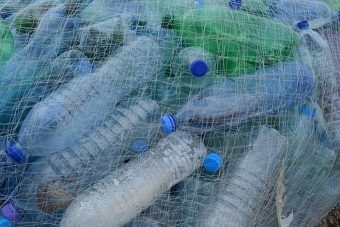
More than 8.3 billion metric tons of plastics have been produced by humans since large-scale production began back in the 1950s, according to a new study published in the journal Science Advances.
Almost all of this plastic now resides as litter or micro-plastics pollution in the natural environment, or buried in landfills. As of 2015, only 9% of the plastics made to date have been recycled, and only 12% incinerated — together accounting for around 2 billion metric tons of plastic — according to the new research. The other 6.3 billion metric tons of plastics that have been produced have become waste (~79%).
Much of the discarded plastic now exists as so-called “micro-plastics” pollution — circulating en masse in the oceans and seas of the world, and present in the seafood that many people eat.
The research predicts that if current trends continue, around 12 billion metric tons of plastic waste will be polluting the natural environment or in landfills by 2050.
“Most plastics don’t biodegrade in any meaningful sense, so the plastic waste humans have generated could be with us for hundreds or even thousands of years,” commented Jenna Jambeck, study co-author and associate professor of engineering at UGA. “Our estimates underscore the need to think critically about the materials we use and our waste management practices.”
“Roughly half of all the steel we make goes into construction, so it will have decades of use — plastic is the opposite,” noted Roland Geyer, lead author of the paper and associate professor in UCSB’s Bren School of Environmental Science and Management. “Half of all plastics become waste after four or fewer years of use.”
The press release provides more: “The scientists compiled production statistics for resins, fibers and additives from a variety of industry sources and synthesized them according to type and consuming sector.
“Global production of plastics increased from 2 million metric tons in 1950 to over 400 million metric tons in 2015, according to the study, outgrowing most other human-made materials. Notable exceptions are materials that are used extensively in the construction sector, such as steel and cement. But while steel and cement are used primarily for construction, plastics’ largest market is packaging, and most of those products are used once and discarded.”
If you take a little step back, one of the shocking bit of perspective about all of this is how fast plastic has invaded our world. “There are people alive today who remember a world without plastics,” Jambeck continued. “But they have become so ubiquitous that you can’t go anywhere without finding plastic waste in our environment, including our oceans.”
Something that the new research revealed that’s particularly interesting is the speed at which plastics production has been increasing in recent years — with roughly half of all the plastics ever produced having been produced in just the last 13 years.
If current rates of production and waste continue, one has to really wonder just how polluted the world’s oceans will be with plastic by 2050.
Source: cleantechnica.com



